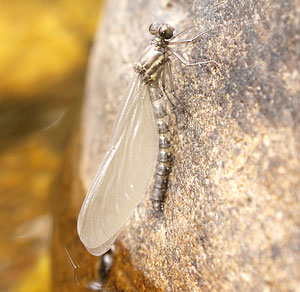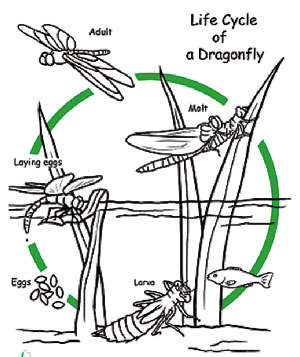Dragonflies Kids for Nature
Odonates have an incomplete metamorphosis and the life stages pass through egg, larvae and adult. Their life cycle is semi-aquatic, as the larval stage is aquatic and the adults are terrestrial.

A newly emerged Shinning Gossamerwing unfolding its wings
The length of the egg stage depends on their development pattern. In the species that have directly developing eggs, hatching takes place within one to eight weeks. Eggs may also have a delayed development and take much longer to hatch depending on environmental conditions. Odonata eggs are usually cream in colour when they are laid and later turn reddish-brown. The rate of development of an egg mainly depends on temperature, though it sometimes depends on the light intensity too.
The larvae of order Odonata are typically aquatic even though some species have adapted to a semi-terrestrial life on wet rocks, moss beds and among moist leaf litter.
All odonate larvae are predators.
They hunt other aquatic invertebrates and sometimes they even hunt tadpoles, small fish and larvae of their own species. All odonate larvae have a characteristically elongated labium
which resembles a mask over their face, which they use to capture prey.
This may be a few centimetres long depending on the size of the larvae.
It contains numerous hooks and
teeth-like structures and the larvae project this forward in a flash and
capture their prey.
Odonata larvae usually inhabit the bottom of shallow water bodies or shallow habitats among aquatic vegetation. This ensures their safety and helps them prevent dislodgement.
They also have dorso-ventrally flat bodies and hook-like sharp claws in their legs to prevent dislodgement. They have well-developed eyes which are helpful in hunting. The bottom-living larvae have many hairs covering their body and these hairs collect mud particles and debris to provide a camouflage.
 Once the larval development is completed, the final instar come out of the water and emerges as an adult. This process of emergence consists of many steps, which occur more or less similarly in all odonata. The fully-developed final instar leaves the water either by climbing up aquatic vegetation or by crawling onto the bank and holding on to a surface. Subsequently, its exoskeleton begins to split from the thorax. Once the splitting is complete, it draws its head and thorax out of the exoskeleton and falls backward. After sometime, it draws itself upwards and gets hold of a surface to which the larvae will attach itself using its legs, and start pulling its abdomen out of the larval exoskeleton.
Once the larval development is completed, the final instar come out of the water and emerges as an adult. This process of emergence consists of many steps, which occur more or less similarly in all odonata. The fully-developed final instar leaves the water either by climbing up aquatic vegetation or by crawling onto the bank and holding on to a surface. Subsequently, its exoskeleton begins to split from the thorax. Once the splitting is complete, it draws its head and thorax out of the exoskeleton and falls backward. After sometime, it draws itself upwards and gets hold of a surface to which the larvae will attach itself using its legs, and start pulling its abdomen out of the larval exoskeleton.
Once it is fully emerged, it stays there for some time until its wings are unfolded and dried. The unfolding of the wings is done by pumping out a liquid from the abdomen. Once the wings are dry, it flies away from the site of emergence. The discarded larval exoskeleton is known as an exuvia.
The emergence of odonates, can take anywhere from twenty minutes to seven hours to complete. This usually takes place before dawn or in the early morning hours in order to minimize being exposed to potential predators. After emergence, newly emerged individuals usually stay away from open habitats for a few days to ensure its protection until it is fully able and active.


